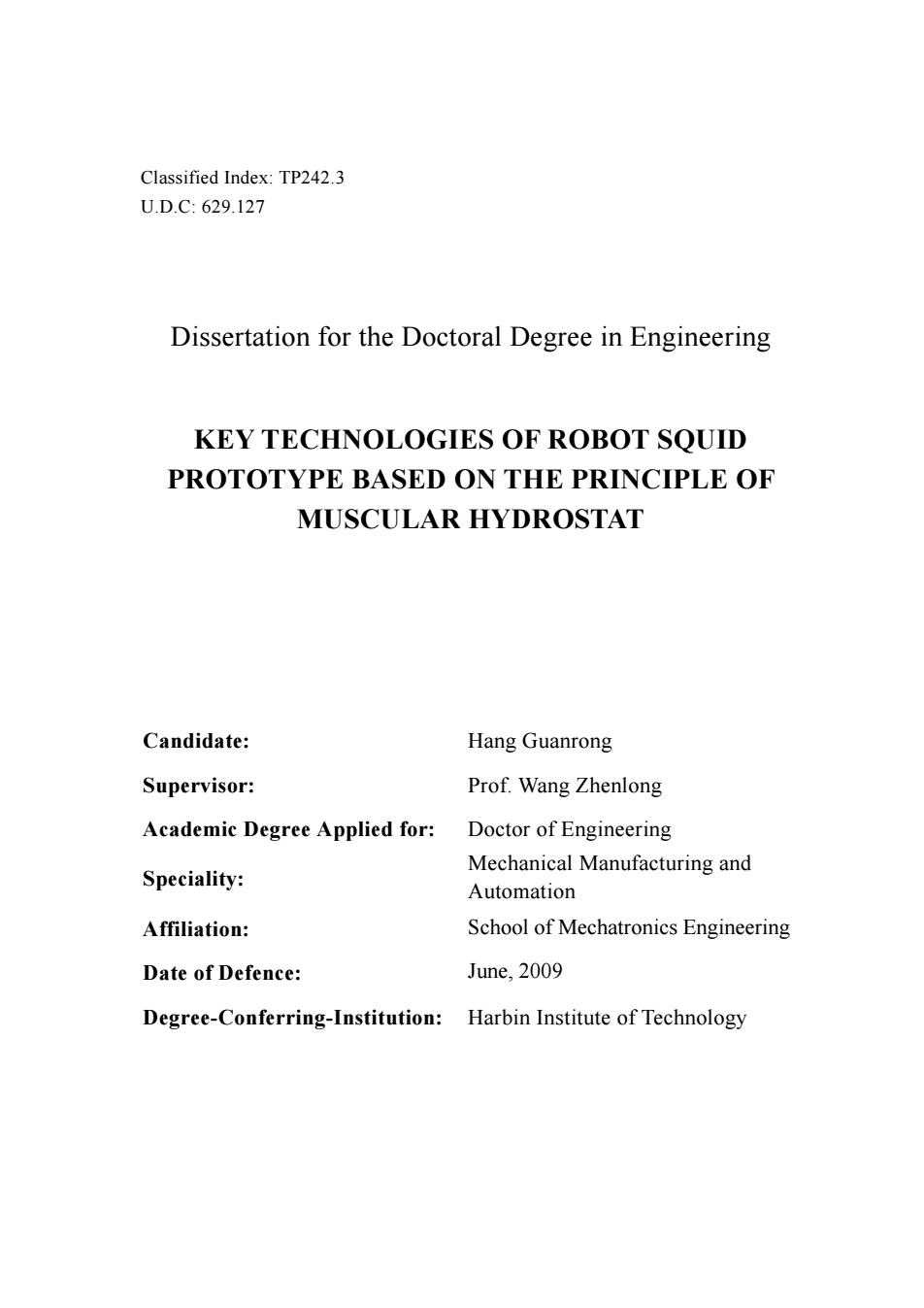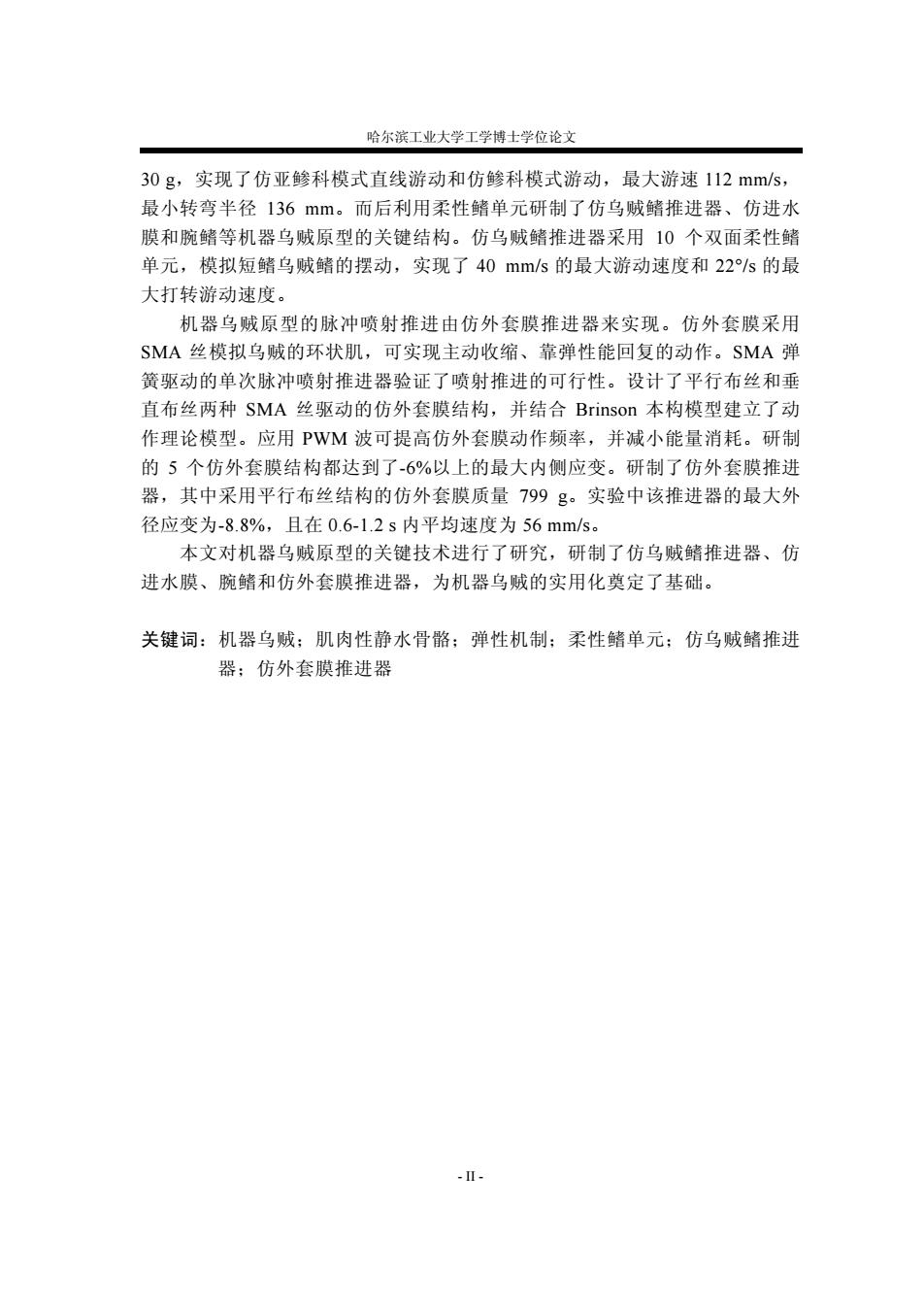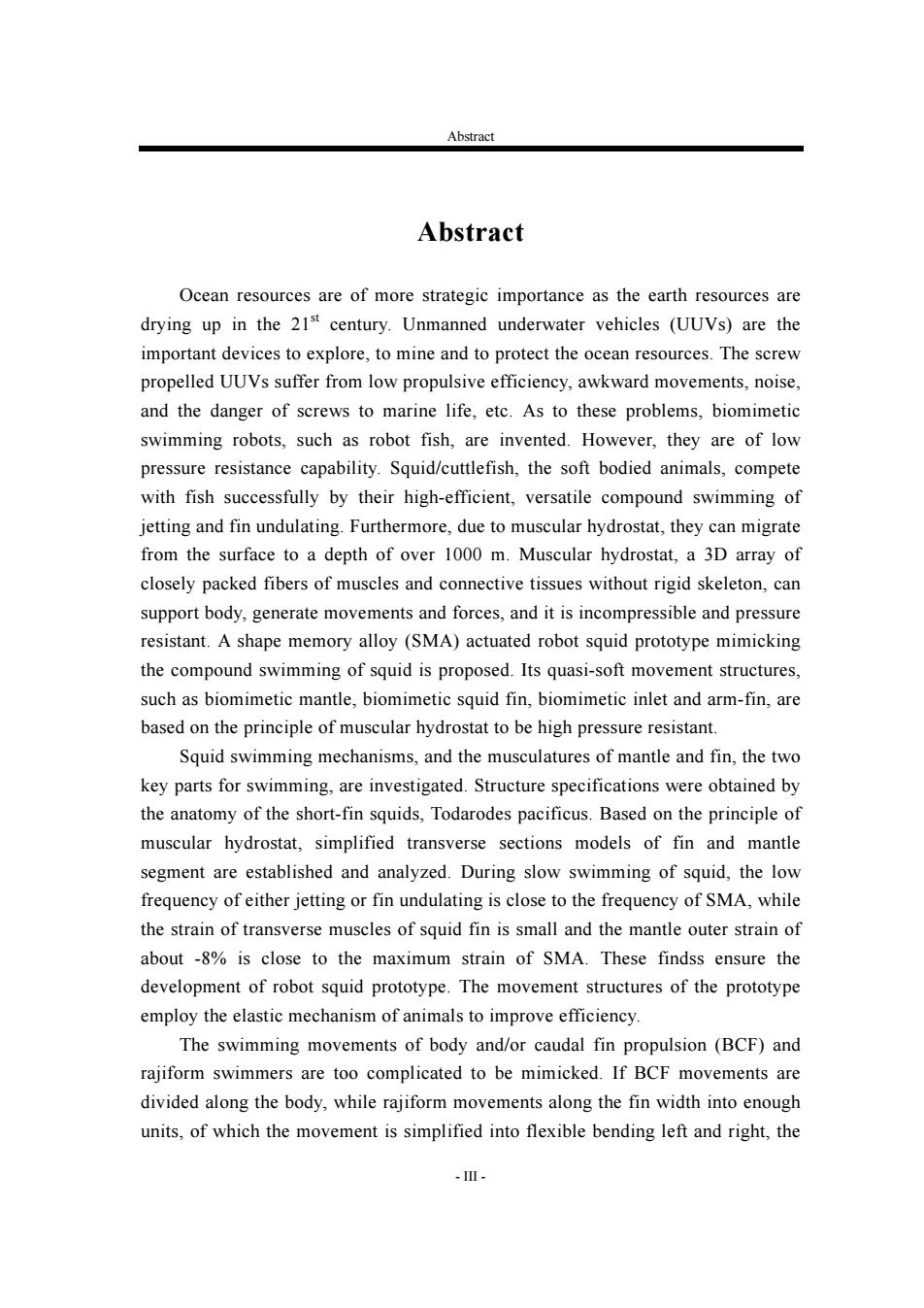
国内图书分类号:TP242.3 学校代码:10213 国际图书分类号:629.127 密级:公开 工学博士学位论文 基于肌肉性静水骨骼原理的机器乌贼原型 关键技术研究 博士研究生:杭观荣 导 师:王振龙教授 申请学位:工学博士 学 科:机械制造及其自动化 所在单位:机电工程学院 答辩日期:2009年6月 授予学位单位:哈尔滨工业大学
国内图书分类号:TP242.3 学校代码: 10213 国际图书分类号:629.127 密级: 公 开 工学博士学位论文 基于肌肉性静水骨骼原理的机器乌贼原型 关键技术研究 博士研究生:杭观荣 导 师:王振龙教授 申请学位:工学博士 学 科:机械制造及其自动化 所 在 单 位:机电工程学院 答 辩 日 期:2009 年 6 月 授予学位单位:哈尔滨工业大学

Classified Index:TP242.3 U.D.C:629.127 Dissertation for the Doctoral Degree in Engineering KEY TECHNOLOGIES OF ROBOT SQUID PROTOTYPE BASED ON THE PRINCIPLE OF MUSCULAR HYDROSTAT Candidate: Hang Guanrong Supervisor: Prof.Wang Zhenlong Academic Degree Applied for: Doctor of Engineering Mechanical Manufacturing and Speciality: Automation Affiliation: School of Mechatronics Engineering Date of Defence: June,2009 Degree-Conferring-Institution:Harbin Institute of Technology
Classified Index: TP242.3 U.D.C: 629.127 Dissertation for the Doctoral Degree in Engineering KEY TECHNOLOGIES OF ROBOT SQUID PROTOTYPE BASED ON THE PRINCIPLE OF MUSCULAR HYDROSTAT Candidate: Hang Guanrong Supervisor: Prof. Wang Zhenlong Academic Degree Applied for: Doctor of Engineering Speciality: Mechanical Manufacturing and Automation Affiliation: School of Mechatronics Engineering Date of Defence: June, 2009 Degree-Conferring-Institution: Harbin Institute of Technology

摘要 摘 要 在地球资源日趋紧张的21世纪,海洋资源日益凸显战略意义。水下机器 人(Unmanned underwater vehicle,UUV)是人类探索、开发和保护海洋资源的 重要工具。螺旋桨推进的水下机器人存在流体推进效率低、动作不灵活、噪音 大、桨叶会伤害海洋动物等问题。针对这些问题,游动仿生水下机器人如机器 鱼应运而生,但它们耐压能力较低。软体动物乌贼凭借喷射和鳍波动的高效、 灵活的复合游动方式,成功地与鱼类竞技海洋:它们依靠肌肉性静水骨骼,活 跃于从上千米的深海至海平面的广阔海域。肌肉性静水骨骼是由在三维方向上 紧密排列的肌肉纤维和结缔组织纤维构成,没有硬骨骼,但能支撑身体、产生 动作和输出力,具有不可压缩、耐高压等性质。本文提出的形状记忆合金 (Shape memory alloy,SMA)驱动的机器乌贼原型,模拟乌贼的复合游动方 式,其仿外套膜、仿乌贼鳍、仿进水膜、腕鳍等准柔性动作结构基于肌肉性静 水骨骼原理,具有耐高压的能力。 对乌贼的游动机理和外套膜、鳍这两个乌贼游动关键部件的肌肉性静水骨 骼结构进行了研究。通过解剖太平洋褶柔鱼(短鳍乌贼),获得了乌贼身体结构 参数。基于肌肉性静水骨骼原理,对简化鳍横截面和外套膜段横截面进行了建 模和分析。乌贼在低速游动时,喷射和鳍波动频率均不高,与SMA的动作频 率相接近;乌贼鳍横肌应变很小,外套膜外径应变在-8%左右,与SMA的最 大应变相接近。这些发现为研制机器乌贼原型提供了可能。该原型的动作结构 采用动物的弹性机制来提高能量利用率。 身体和/或尾鳍模式(Body and/,or caudal fin propulsion,BCF)和鳐科模式推 进的动物的游动动作较为复杂,模拟较为困难,但若将前者沿着身体方向、后 者沿着鳍宽度方向划分成足够多的小单元,将每个单元的动作简化为向左右柔 性弯曲,则通过将这些弯曲单元串联或并联组合即能重现相应的游动动作。基 于这一设想,研制了模拟乌贼鳍结构的柔性鳍单元,SMA丝模拟横肌,在动 作过程中模拟动物的弹性机制存储和释放弹性能,减小能量消耗。结合SMA 的Brinson本构模型建立了柔性鳍单元的弯曲动作理论模型。实验表明柔性鳍 单元可在空气中和水中实现柔性弯曲和回复的动作。柔性鳍单元具有弯曲角度 大、结构简单、质量小、输出力大、动作无声和模块化等优点。 通过研制采用一个柔性鳍单元的尾鳍推进微型机器鱼,验证了柔性鳍单元 用于水下推进的可行性。该机器鱼长146mm(采用仿鲫鱼型尾鳍时),质量约 -1-
摘 要 - I - 摘 要 在地球资源日趋紧张的 21 世纪,海洋资源日益凸显战略意义。水下机器 人(Unmanned underwater vehicle,UUV)是人类探索、开发和保护海洋资源的 重要工具。螺旋桨推进的水下机器人存在流体推进效率低、动作不灵活、噪音 大、桨叶会伤害海洋动物等问题。针对这些问题,游动仿生水下机器人如机器 鱼应运而生,但它们耐压能力较低。软体动物乌贼凭借喷射和鳍波动的高效、 灵活的复合游动方式,成功地与鱼类竞技海洋;它们依靠肌肉性静水骨骼,活 跃于从上千米的深海至海平面的广阔海域。肌肉性静水骨骼是由在三维方向上 紧密排列的肌肉纤维和结缔组织纤维构成,没有硬骨骼,但能支撑身体、产生 动作和输出力,具有不可压缩、耐高压等性质。本文提出的形状记忆合金 (Shape memory alloy,SMA)驱动的机器乌贼原型,模拟乌贼的复合游动方 式,其仿外套膜、仿乌贼鳍、仿进水膜、腕鳍等准柔性动作结构基于肌肉性静 水骨骼原理,具有耐高压的能力。 对乌贼的游动机理和外套膜、鳍这两个乌贼游动关键部件的肌肉性静水骨 骼结构进行了研究。通过解剖太平洋褶柔鱼(短鳍乌贼),获得了乌贼身体结构 参数。基于肌肉性静水骨骼原理,对简化鳍横截面和外套膜段横截面进行了建 模和分析。乌贼在低速游动时,喷射和鳍波动频率均不高,与 SMA 的动作频 率相接近;乌贼鳍横肌应变很小,外套膜外径应变在-8%左右,与 SMA 的最 大应变相接近。这些发现为研制机器乌贼原型提供了可能。该原型的动作结构 采用动物的弹性机制来提高能量利用率。 身体和/或尾鳍模式(Body and/or caudal fin propulsion,BCF)和鳐科模式推 进的动物的游动动作较为复杂,模拟较为困难,但若将前者沿着身体方向、后 者沿着鳍宽度方向划分成足够多的小单元,将每个单元的动作简化为向左右柔 性弯曲,则通过将这些弯曲单元串联或并联组合即能重现相应的游动动作。基 于这一设想,研制了模拟乌贼鳍结构的柔性鳍单元,SMA 丝模拟横肌,在动 作过程中模拟动物的弹性机制存储和释放弹性能,减小能量消耗。结合 SMA 的 Brinson 本构模型建立了柔性鳍单元的弯曲动作理论模型。实验表明柔性鳍 单元可在空气中和水中实现柔性弯曲和回复的动作。柔性鳍单元具有弯曲角度 大、结构简单、质量小、输出力大、动作无声和模块化等优点。 通过研制采用一个柔性鳍单元的尾鳍推进微型机器鱼,验证了柔性鳍单元 用于水下推进的可行性。该机器鱼长 146 mm(采用仿鲫鱼型尾鳍时),质量约

哈尔滨工业大学工学博士学位论文 30g,实现了仿亚鲹科模式直线游动和仿鲹科模式游动,最大游速112mm/s, 最小转弯半径136mm。而后利用柔性鳍单元研制了仿乌贼鳍推进器、仿进水 膜和腕鳍等机器乌贼原型的关键结构。仿乌贼鳍推进器采用10个双面柔性鳍 单元,模拟短鳍乌贼鳍的摆动,实现了40mm/s的最大游动速度和22°/s的最 大打转游动速度。 机器乌贼原型的脉冲喷射推进由仿外套膜推进器来实现。仿外套膜采用 SMA丝模拟乌贼的环状肌,可实现主动收缩、靠弹性能回复的动作。SMA弹 簧驱动的单次脉冲喷射推进器验证了喷射推进的可行性。设计了平行布丝和垂 直布丝两种SMA丝驱动的仿外套膜结构,并结合Brinson本构模型建立了动 作理论模型。应用PWM波可提高仿外套膜动作频率,并减小能量消耗。研制 的5个仿外套膜结构都达到了-6%以上的最大内侧应变。研制了仿外套膜推进 器,其中采用平行布丝结构的仿外套膜质量799g。实验中该推进器的最大外 径应变为-8.8%,且在0.6-1.2s内平均速度为56mm/s。 本文对机器乌贼原型的关键技术进行了研究,研制了仿乌贼鳍推进器、仿 进水膜、腕鳍和仿外套膜推进器,为机器乌贼的实用化奠定了基础。 关键词:机器乌贼:肌肉性静水骨骼:弹性机制:柔性鳍单元:仿乌贼鳍推进 器:仿外套膜推进器 --
哈尔滨工业大学工学博士学位论文 - II - 30 g,实现了仿亚鲹科模式直线游动和仿鲹科模式游动,最大游速 112 mm/s, 最小转弯半径 136 mm。而后利用柔性鳍单元研制了仿乌贼鳍推进器、仿进水 膜和腕鳍等机器乌贼原型的关键结构。仿乌贼鳍推进器采用 10 个双面柔性鳍 单元,模拟短鳍乌贼鳍的摆动,实现了 40 mm/s 的最大游动速度和 22°/s 的最 大打转游动速度。 机器乌贼原型的脉冲喷射推进由仿外套膜推进器来实现。仿外套膜采用 SMA 丝模拟乌贼的环状肌,可实现主动收缩、靠弹性能回复的动作。SMA 弹 簧驱动的单次脉冲喷射推进器验证了喷射推进的可行性。设计了平行布丝和垂 直布丝两种 SMA 丝驱动的仿外套膜结构,并结合 Brinson 本构模型建立了动 作理论模型。应用 PWM 波可提高仿外套膜动作频率,并减小能量消耗。研制 的 5 个仿外套膜结构都达到了-6%以上的最大内侧应变。研制了仿外套膜推进 器,其中采用平行布丝结构的仿外套膜质量 799 g。实验中该推进器的最大外 径应变为-8.8%,且在 0.6-1.2 s 内平均速度为 56 mm/s。 本文对机器乌贼原型的关键技术进行了研究,研制了仿乌贼鳍推进器、仿 进水膜、腕鳍和仿外套膜推进器,为机器乌贼的实用化奠定了基础。 关键词:机器乌贼;肌肉性静水骨骼;弹性机制;柔性鳍单元;仿乌贼鳍推进 器;仿外套膜推进器

Abstract Abstract Ocean resources are of more strategic importance as the earth resources are drying up in the 21st century.Unmanned underwater vehicles (UUVs)are the important devices to explore,to mine and to protect the ocean resources.The screw propelled UUVs suffer from low propulsive efficiency,awkward movements,noise, and the danger of screws to marine life,etc.As to these problems,biomimetic swimming robots,such as robot fish,are invented.However,they are of low pressure resistance capability.Squid/cuttlefish,the soft bodied animals,compete with fish successfully by their high-efficient,versatile compound swimming of jetting and fin undulating.Furthermore,due to muscular hydrostat,they can migrate from the surface to a depth of over 1000 m.Muscular hydrostat,a 3D array of closely packed fibers of muscles and connective tissues without rigid skeleton,can support body,generate movements and forces,and it is incompressible and pressure resistant.A shape memory alloy(SMA)actuated robot squid prototype mimicking the compound swimming of squid is proposed.Its quasi-soft movement structures, such as biomimetic mantle,biomimetic squid fin,biomimetic inlet and arm-fin,are based on the principle of muscular hydrostat to be high pressure resistant. Squid swimming mechanisms,and the musculatures of mantle and fin,the two key parts for swimming,are investigated.Structure specifications were obtained by the anatomy of the short-fin squids,Todarodes pacificus.Based on the principle of muscular hydrostat,simplified transverse sections models of fin and mantle segment are established and analyzed.During slow swimming of squid,the low frequency of either jetting or fin undulating is close to the frequency of SMA,while the strain of transverse muscles of squid fin is small and the mantle outer strain of about -8%is close to the maximum strain of SMA.These findss ensure the development of robot squid prototype.The movement structures of the prototype employ the elastic mechanism of animals to improve efficiency. The swimming movements of body and/or caudal fin propulsion (BCF)and rajiform swimmers are too complicated to be mimicked.If BCF movements are divided along the body,while rajiform movements along the fin width into enough units,of which the movement is simplified into flexible bending left and right,the -Ⅲ-
Abstract - III - Abstract Ocean resources are of more strategic importance as the earth resources are drying up in the 21st century. Unmanned underwater vehicles (UUVs) are the important devices to explore, to mine and to protect the ocean resources. The screw propelled UUVs suffer from low propulsive efficiency, awkward movements, noise, and the danger of screws to marine life, etc. As to these problems, biomimetic swimming robots, such as robot fish, are invented. However, they are of low pressure resistance capability. Squid/cuttlefish, the soft bodied animals, compete with fish successfully by their high-efficient, versatile compound swimming of jetting and fin undulating. Furthermore, due to muscular hydrostat, they can migrate from the surface to a depth of over 1000 m. Muscular hydrostat, a 3D array of closely packed fibers of muscles and connective tissues without rigid skeleton, can support body, generate movements and forces, and it is incompressible and pressure resistant. A shape memory alloy (SMA) actuated robot squid prototype mimicking the compound swimming of squid is proposed. Its quasi-soft movement structures, such as biomimetic mantle, biomimetic squid fin, biomimetic inlet and arm-fin, are based on the principle of muscular hydrostat to be high pressure resistant. Squid swimming mechanisms, and the musculatures of mantle and fin, the two key parts for swimming, are investigated. Structure specifications were obtained by the anatomy of the short-fin squids, Todarodes pacificus. Based on the principle of muscular hydrostat, simplified transverse sections models of fin and mantle segment are established and analyzed. During slow swimming of squid, the low frequency of either jetting or fin undulating is close to the frequency of SMA, while the strain of transverse muscles of squid fin is small and the mantle outer strain of about -8% is close to the maximum strain of SMA. These findss ensure the development of robot squid prototype. The movement structures of the prototype employ the elastic mechanism of animals to improve efficiency. The swimming movements of body and/or caudal fin propulsion (BCF) and rajiform swimmers are too complicated to be mimicked. If BCF movements are divided along the body, while rajiform movements along the fin width into enough units, of which the movement is simplified into flexible bending left and right, the